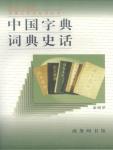Chapter 1 Chapter 1 Ancient Chinese Characters and Books——A Bridge for Learning Ancient Chinese and Reading Ancient Books
As the name suggests, dictionaries contain single words, and dictionaries contain monosyllabic, disyllabic, and polysyllabic words.But as far as ancient Chinese is concerned, since monosyllabic words are dominant, a character is often equivalent to a word, and there is no strict distinction between characters and words.In fact, most of the ancient books explaining characters contain both single characters and complex words, including dictionaries and dictionaries. Moreover, those who explain characters must talk about the system of names and objects, and those who explain words must also explain the meaning of words. There are no definite boundaries.Therefore, in ancient my country, books that explain the shape and composition of characters and the pronunciation and meaning of characters, and arrange them in a certain way are collectively referred to as calligraphy.The use of dictionaries as the title of books explaining characters began with the "Kangxi Dictionary". The "dictionary" that people in the Qing Dynasty called refers to this book.
Since modern times, the polyphony of Chinese vocabulary has accelerated, and diphonic words have dominated, and specialized words have become increasingly abundant, and foreign words have increased, and words and words are not equal. This has become more and more obvious, and the distinction between dictionaries and dictionaries is necessary.However, polysyllabic words are often attached to the entries of modern dictionaries, and most of the characters are words; polysyllabic words and phrases.Of course, dictionaries in the modern sense not only refer to dictionaries and dictionaries that explain words, but also include various types of specialized dictionaries, such as place-name dictionaries, and even encyclopedias, which are much wider than ancient dictionaries.
We now call the study of the origin, development, nature, and system of characters, and the relationship between the form, sound and meaning of characters as philology.In ancient times, the knowledge related to the study of characters was called "primary school"; ancient historical annals also classified works such as exegesis, phonology and rhyme of characters into the category of "primary school".Ancient calligraphy all belong to the scope of "elementary school".
"Primary school" in the Zhou Dynasty refers to schools run for noble children aged eight to 14. "Primary school" means that young children learn to read characters at school, and teachers explain the shape and structure of characters to them.Ban Gu of the Eastern Han Dynasty (32-92 A.D.)’s "Hanshu Yiwenzhi" appended the book of characters used for children’s literacy and the book explaining the meaning of the words to the "Six Art Briefs" of Confucian classics, collectively referred to as "primary school".In this way, the meaning of "elementary school" has gradually changed, and literacy has become a specialized knowledge, which includes: explaining the physical structure of characters, "notifying ancient and modern characters" (notifying means knowing), "positive reading" and so on.From the Eastern Han Dynasty to the Sui, Tang and Five Dynasties, the content of "elementary school" became more abundant, including books discussing the shape of characters and phonology.Until the Tang Dynasty compiled "Old Tang Book·Jing Ji Zhi", "Erya" and other books were classified as "primary school". Since then, the basic content of "primary school" has been determined.In the Song Dynasty, some people began to call "primary school" "the study of characters", and divided the content of the study of characters into three categories: system (character shape), exegesis (character meaning), and phonology (character sound).
In the Qing Dynasty, the "Summary of the General Catalog of Siku Quanshu" divided language and characters into three categories: exegesis, calligraphy, and rhyme. Books such as "Erya" are classified as exegesis, books such as "Shuowen Jiezi" are classified as calligraphy books, and books such as "Guangyun" are classified as rhyme books, so that the scope of "elementary school" is more clear .Generally speaking, exegetical books such as "Erya" focus on the meaning of characters, "Shuowen Jiezi" mainly focuses on explaining the shape of characters, and emphasize the relationship between the shape, sound and meaning of characters, and "Guangyun" The rhyme book mainly focuses on the pronunciation of characters, and also simply explains the shape and meaning of characters, which also plays the role of calligraphy.Therefore, "elementary school" refers to the study of characters. Books in the category of "elementary school" mainly refer to calligraphy books. The content of "elementary school" in ancient times gradually enriched with the development of the times.It can be said that the emergence and evolution of ancient Chinese dictionaries and dictionaries are inseparable from the traditional "elementary school".

